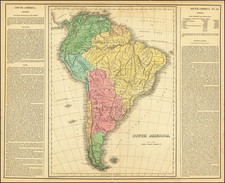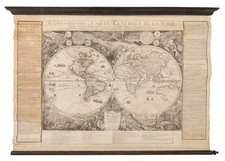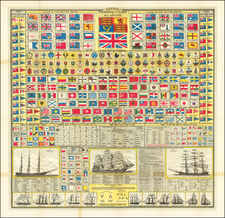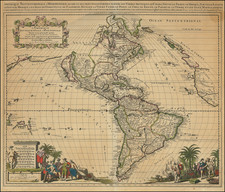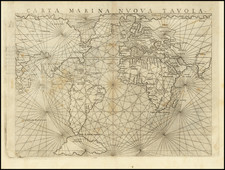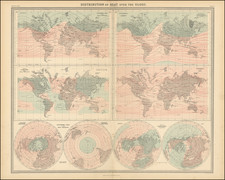A flawless example of De Bry's scarce and dramatic map of the New World shown in a sphere and bordered by full-length portraits of Columbus, Vespucci, Magellan and Pizarro. The cartography is derived primarily from Plancius' world map of 1594, providing a relatively correct shape for the period and showing a vast southern landmass extending from New Guinea to Tierra del Fuego and beyond. The map accompanies Part six of De Bry's Grand Voyages. It incorporates information acquired by Cornelis Claesz in 1594 from the Lasso chart, showing a single insular Newfoundland. Also incorporated for the first time on an American map is information from White and Le Moyne along the Souteast Coast of North America. This example has remarkably wide clean margins and virtually no trace of the original single fold. The plate strike is very dark and fresh, from and early pull. As such, it is one of the finest examples to appear on the market in some time. Most examples of the map have varying degrees of fold damage and loss, making this a truly exceptional example. Burden 91.
Theodor de Bry (1528-1598) was a prominent Flemish engraver and publisher best known for his engravings of the New World. Born in Liege, de Bry hailed from the portion of Flanders then controlled by Spain. The de Brys were a family of jewelers and engravers, and young Theodor was trained in those artisanal trades.
As a Lutheran, however, his life and livelihood were threatened when the Spanish Inquisition cracked down on non-Catholics. De Bry was banished and his goods seized in 1570. He fled to Strasbourg, where he studied under the Huguenot engraver Etienne Delaune. He also traveled to Antwerp, London, and Frankfurt, where he settled with his family.
In 1590, de Bry began to publish his Les Grands Voyages, which would eventually stretch to thirty volumes released by de Bry and his two sons. The volumes contained not only important engraved images of the New World, the first many had seen of the geographic novelties, but also several important maps. He also published a collection focused on India Orientalis. Les Grands Voyages was published in German, Latin, French, and English, extending de Bry’s fame and his view of the New World.









